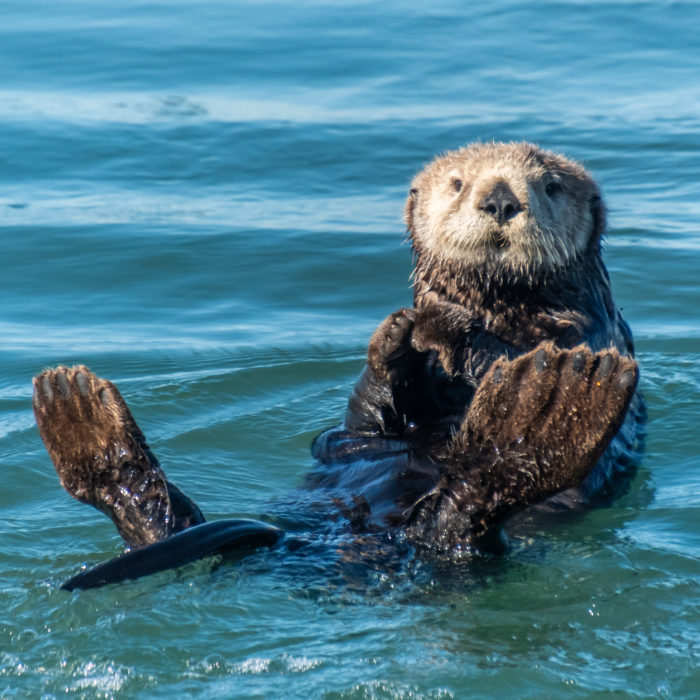
Sea Wonder: Sea Otter

Photo Credit: Douglas Croft
They’re cute and cuddly with the most dense fur of any mammal on earth and teeth that are twice as strong as our own. This sea wonder is none other than the sea otter!
Appearance
Sea otters are a species of mammal related to other mustelids (wolverines, badgers, ferrets, and river otters). They can reach a maximum length of about four feet and weigh around 65 pounds on average when fully grown. Their coats of thick fur create an insulating layer that keeps them warm and dry in the cold waters they call home. With the most dense fur of any mammal, sea otters can have more than one million hairs per square inch of their bodies.
Their bodies are dark brown and black while their small heads are lighter brown. They have small, visible ears, two black eyes, a triangular nose, and many whiskers used for sensory purposes above their mouths. Within their mouths are 32 sharp, chip-resistant teeth used to crush the shells of their prey. Sea otters have a long tail accounting for nearly a third of their body length and four webbed, clawed feet, which they use to navigate land and catch, break, and eat their prey.
Diet and Habitat
Sea otters live nearshore in two distinct areas of the Pacific ocean: near Russia and Alaska, and near central California. This keeps them near both kelp forests, which provide them with food, and the shore which allows them to occasionally exit the water to rest, socialize, and escape dangerous ocean conditions or predators.

Photo Credit: NOAA
Sea otters are opportunistic feeders, meaning they will eat what is easiest to catch. Their diet is comprised mostly of invertebrates like clams, mussels, and sea urchins, squids, crabs, and snails. To catch their food, which primarily lives on the seafloor near kelp forests, sea otters will close their nostrils and ears to dive down, grab prey with their front paws, and bring it back to the surface. For shelled animals like clams and mussels, they might float on their backs with the prey on their belly, banging it with a rock until the animal separates from the rock it was attached to or its flesh is revealed and the otter can eat it. These marine mammals have incredibly high metabolisms due to the fact that they need to regulate their body temperature in the colder waters of the Pacific ocean, so they have to eat between 20 and 30 percent of their body weight per day. For a 65 pound otter, this is as much as 20 pounds of food per day!
Sea otters are known as keystone species in their food web. Their presence keeps their prey populations in balance, which has secondary and tertiary effects on the environment. By eating sea urchins, which graze on kelp, sea otters protect kelp forests from overgrazing. This benefits species that rely on kelp forests for shelter or feeding, and the reduction of kelp predation can help in the capture and storage of atmospheric carbon by kelp plants.
Life History
After a six-month pregnancy, sea otters give birth to a single pup. Peak pupping season for California sea otters is between March and September, but scientists believe they give birth throughout the year, with individuals females giving birth every two or three years. Most sea otter births occur in the water and pups begin swimming and nursing almost immediately. Females will nurse their pups for up to eight months and during that time teach them to hunt,
navigate, and socialize. Sea otters may live as long as 15 years, with an average lifespan around 10.
Sea otters live in small groups, usually separated into groups of adult males and groups of females, their pups, and several juveniles. Groups of adult males and females will occasionally cross paths throughout the year based on food availability and mating cycles. Sea otters may pair off within their larger social groups to forage, groom, or rest, sometimes even interlocking their paws for stability in the water.
Threats and Conservation
Hunted for their dense fur in the 1800s, sea otters were nearly declared extinct. Fortunately, they received protection under the Fur Seal Treaty of 1911 that prohibited the hunting and skinning of sea otters, and they received further protection with the passing of the Marine Mammal Protection Act in 1972. Unfortunately, sea otter populations remain endangered under both the ICU Red List and threatened on the United States Endangered Species List with populations continuing to decline due to coastal development, human interactions (including shooting), fishing gear interactions, pollution and oil spills, and prey scarcity due to kelp forest loss. Scientists and managers are hopeful sea otter populations will become more stable in the future with interventions like animal rescue, rehabilitation, and release and policies that protect the marine environment.
